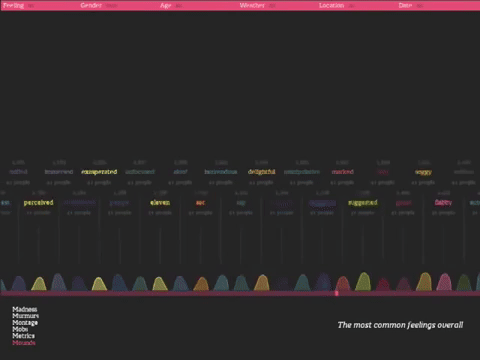A Typology of Our Online Expressions
Murmurs, wanderings, echoes, performances: social media leads us to new behaviors between emotions and the formalization of our thoughts, influenced by digital platforms.
Good evening from Paris! Welcome to the latest edition of this newsletter. A special welcome to our new subscribers—you can explore all previous editions right here.
In 2005, Sep Kamvar and Jonathan Harris launched We Feel Fine, an almanac of human emotions online, which captured the essence of blog posts and tweets every 10 minutes. For the first time in history, we realized that all our online contributions were not just strings of 0s and 1s, but real feelings, sensations, and movements that followed certain patterns.
One of the most interesting features of We Feel Fine was filtering emotions based on the day’s weather. It showed us that our online expressions changed with the temperature, and that we were—unconsciously—part of larger social and cultural patterns.
Twenty years later, online expressions seem more strained, increasingly complex. They have become a resource coveted by platforms to keep us engaged and monetize for their own survival, as Caroline Busta highlights for Document.
“This makes sense given that the internet runs on human expression. Affect-rich content drives platform engagement and therefore data cultivation—data that is used locally to build out identities of individual users, as well as anonymized data that is sold (or externally scraped) in bulk for use by third parties such as Shein or programmatic ad brokers.”
Caroline Busta
I attempt to develop an imperfect typology of online expressions, shaped by digital platforms that have made digital liveness—the quality or state of being alive—ever more pervasive and ever more political.
Murmurs vs. Noise
Murmurs: Fleeting thoughts, often personal, shared without much intent. For example, Instagram stories, random tweets on X, or ephemeral snaps. This type of content reflects an ostensibly passive communication, more spontaneous expression than a call for engagement. Yet, through repetition, these whispers become our signature, our tone for our followers. Paradoxically, whispers create attention, like a teacher who deliberately lowers their voice to capture the attention of a rowdy class.
Noise: Similar in form, noise represents the overwhelming abundance of random, harsh, or superficial thoughts shared online. It contributes to digital clutter, often lacking much articulation. This noise—fundamentally harsher—captivates more by its sheer presence than by substance. It’s particularly prevalent during election periods, where political groups flood social media more to occupy the space than to truly convince.
Wanderings vs. Doom-Scrolling
Wanderings: This refers to casually navigating from post to post or thread to thread, with no real agenda but with a sense of discovery. A light and relaxing exploration of digital content, often inspiring. Fernweh—the longing for distant places—also drives this pleasant wandering. You seek hidden gems, unseen content, like a flâneur without constraints.

Doom-Scrolling: The darker version of wandering, where the user is sucked into a spiral of negative content, often alarming news or anxiety-inducing posts, amplifying feelings of despair. A form of trap that shackles our minds as our thumbs take the place of handcuffs.
Crowds vs. Collective Movements
Crowds: Online crowds represent reactive and impulsive participation in massive events, or even collective outrage in the form of viral “pile-ons,” boycott campaigns, or polarizing hashtags. Here, the motivation is often emotional rather than rational, with a dominant mob effect.
Collective Movements: A more organized and intentional form of collective expression, such as activism for social causes, crowdfunding campaigns, or large-scale creative collaborations. This digital mass seems more constructive and meaningfully purposeful.
Echoes vs. Resonance
Echoes: This refers to the repetitive sharing or engagement with content that loops algorithmically. It involves retweets, shares, and likes that amplify content already widely spread, without adding much value. Echoes are not just textual either—they can be aesthetic trends or even video montages, driven by TikTok and its CapCut tool. The Wes Anderson trend will certainly remain a textbook example.
Tiktok failed to load.
Enable 3rd party cookies or use another browserResonance: A deeper engagement, where content, in addition to spreading, sparks meaningful conversations, more thoughtful reflections, or real-world actions. Posts that inspire tangible changes or long-term cultural transformations belong to this category.
Performance vs. Being
Performance: The act of creating an online persona, where the content is carefully edited or filtered to match an image one wishes to project. This includes influencers building their brand or users filtering their reality to fit a particular aesthetic.

Being: A more authentic form of digital expression, where people share their experiences without worrying about aesthetics or social validation. Whether it’s a vulnerable post or raw, unfiltered thoughts, this is about living online in a truer way. It should be noted that being can increasingly be fabricated, leading to greater confusion between what is “real” and… what is truly real.
Hyperlink vs. Deep Link
Hyperlink: The casual act of linking content, creating connections without much thought or deep meaning. This often manifests in quick posts or comments where users share articles without truly reflecting on them. This is often how fake news spreads, through mechanical sharing.
Deep Link: More intentional, deep linking involves establishing connections between content that adds real value to the discussion. For example, linking a relevant article in a well-researched blog post or creating a knowledge chain around a subject.
Spectator vs. Observer-Participant
Spectator: Passive consumption, where one observes without truly engaging. Lurking on social media, consuming content without commenting or reacting, simply witnessing the flow of information.
Observer-Participant: Active involvement, whether through comments, creating original content, or participating in discussions. Participation pushes digital boundaries, turning the user into a contributor rather than a mere observer. This is more typical on platforms like Twitch or during livestreams.
Sparks vs. Flames
Sparks: Quick and temporary engagements, such as liking a post, leaving a one-word comment, or scrolling without deeper interaction. It’s the digital equivalent of a quick glance.
Flames: Sustained digital engagement: passionate discussions in comment threads, online debates, or posts that spark long-lasting interactions.
Mules vs. Geo-anonymous
Mules: Users who unknowingly or consciously “carry” trackers and cookies, influencing at a large scale the content that will be distributed to people with similar traits.
Geo-anonymous: Leaving the least exploitable traces by third-party stakeholders. Expressions that require a high level of mastery of digital platforms and sophisticated tools.
The Media Object of the Week
Miu Miu released The Truthless Times during their Paris show, a fictitious newspaper with numerous essays to discover. They were available via QR codes around the celebrity photocall and hosted in a folder on Miu Miu’s website, in .pdf format.
We're in the endcore now - Shumon Bascar
Glitch is anti-body - Legacy Russel
A shorthand: on a hoodie, Foucault enters a basketball court - Sònia Mbuji-Mayi Deulofeu
Welcome to the psychopolitics of AI - Kate Crawford
Don't be yourself - Eudald Espluga I Casademont
The last resort - Yaiza Hernández Velázquez
(You can read them on my Google Docs - just request access)
Amazing links
I was interviewed about LOEWE’s iconic status (The Drum).
I contributed to an analysis of the “Front Row” at Fashion Weeks (Business of Fashion).
The impact of screen time on the adult brain (Stanford).
Have a great week! This newsletter is written with love, passion, and (French) café.
Feel free to share this newsletter, like, comment, or keep sending me emails: these notifications are a joy.
My book “Alive In Social Media” is available on Amazon.









